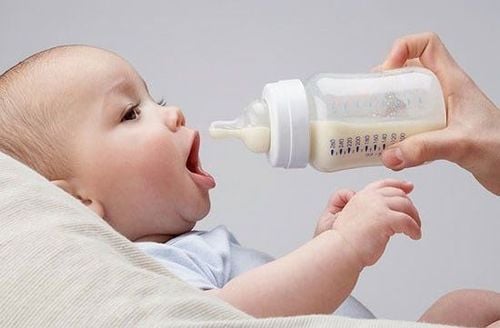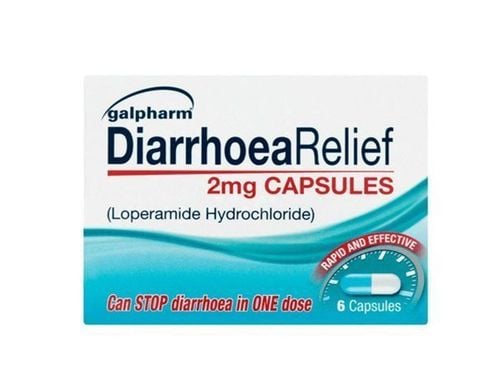This is an automatically translated article.
Article written by Doctor Ho Thi Anh Thu - Neonatologist - Department of Pediatrics - Neonatology - Vinmec Nha Trang International General Hospital
Gastroesophageal reflux disease (GERD) is a condition in which milk is regurgitated or regurgitated. This occurs when stomach contents back up into the esophagus or mouth. Because the stomach produces acid, reflux is sometimes called acid reflux.
1. Overview
Gastroesophageal reflux is a normal condition that occurs in infants, children, and adults. Most babies have short episodes where they can spit milk through their mouth or nose. Reflux usually doesn't affect the baby, has little risk of long-term complications, and usually doesn't require treatment.
In contrast, in some children, gastroesophageal reflux causes complications such as delayed weight gain, recurrent pneumonia or vomiting blood. In this case, the child is considered to have gastroesophageal reflux disease.
Children with these signs and symptoms often need further testing and treatment. Children with abdominal pain or unusual fussiness should seek medical attention. In most cases, children do not have reflux disease. Most often the disease improves as the child gets older, but some children still have symptoms later in life.
2. What is Gastroesophageal Reflux?
When you eat, food is passed from the mouth to the stomach through the esophagus, a tubular structure. The esophagus is made up of layers of tissue and muscle, which can open and contract to push food to the stomach through a series of wave-like movements called peristalsis.
At the lower end of the esophagus where it joins the stomach, there is a circular muscle called the lower esophageal sphincter. This muscle relaxes to allow food to pass into the stomach and then contracts to prevent the reflux of food and acid into the esophagus.
Sometimes, this muscle does not close completely or relaxes at the wrong time, allowing stomach liquid to back up into the esophagus, especially common in young children. Most of these attacks are invisible because the reflux occurs in the esophagus.
As the child gets older and the junction between the stomach and the esophagus changes, the reflux will be less. Breastfeeding disappears in more than 50% of babies by 10 months, 80% by 18 months, and 98% by two years [1]. Infants who frequently spit up milk during the first trimester are more likely to have gastrointestinal symptoms later in life.

2.1 Uncomplicated Gastroesophageal Reflux Reflux is common in babies in the first few months of life, about 50% of babies from birth to three months have at least one spit of milk per day.
Babies who spit up milk frequently but feed well, gain weight normally, and are not irritable are generally considered to have “uncomplicated” reflux. In this group, regurgitation is normal because the esophagus is short and the stomach is small, allowing liquid to pass out of the stomach easily. Frequent burping during feeding and limiting activity after feeding can reduce the frequency and amount of regurgitation.
Tests are not needed for children with uncomplicated reflux. If the child has the following signs, it is necessary to take the child to the doctor: the symptoms get worse; younger than 6 months of first appearance of reflux; or symptoms do not improve by the time the child is 18 to 24 months old.
2.2 Uncomplicated Gastroesophageal Reflux Disease Reflux becomes a disease when the acid in the refluxed substance causes problems such as: worsening asthma, growth retardation, or damage to the esophagus. Only a few children with reflux have these problems. Esophageal damage is easy to occur when reflux is frequent, the amount of reflux is high.
Some signs that your baby is sick include refusing to eat, often crying or arching the neck and back such as pain, choking when spitting milk, vomiting, vomiting blood, coughing often or not gaining weight.
It is often difficult to tell if a young child is in pain. In general, a healthy baby is when a baby cries that can be comforted by comforting, distracting, or responding to a baby's needs (hunger, sleep, or diaper change).
2.3 Irritability and Reflux Many parents worry that reflux is the cause of their child's irritability or trouble sleeping. However, clinical studies have shown that reflux is usually painless and that reducing gastric acid does not improve irritability [2,3].
Discomfort and trouble sleeping are problems that can be related to a number of medical conditions. Should take the child to the doctor when the child is irritable and often spits milk.
3. Diagnosis of gastroesophageal reflux disease
To diagnose gastroesophageal reflux disease, the doctor needs to take the medical history and perform a physical examination; At the same time, if the pathology is suspected, some necessary laboratory tests may be indicated such as:
● Blood or urine test.
● Take a contrast-enhanced esophagogram to evaluate the child's swallowing level and evaluate the anatomy of the stomach.
● In addition, endoscopy can be performed if necessary to evaluate the condition of the esophageal mucosa.

4. Gastroesophageal reflux treatment
Children with uncomplicated reflux do not need treatment. Infants with reflux disease are usually treated first with lifestyle changes, including: avoiding overfeeding, avoiding exposure to secondhand smoke, being held up after feedings, and a cow's milk diet. , and solid food.
Many children with reflux symptoms will improve with non-pharmacological measures. In one study, more than 80% of infants experienced partial or complete improvement with non-pharmacological measures alone, including solid feeding, avoidance of second-hand smoke, and trying a cow's milk (fully hydrolysed) diet. or the mother should limit cow's protein intake if breast-feeding).
4.1 Cow's Diet Some cases of gastroesophageal reflux disease are caused by cow's milk. The most common cause is cow's milk protein intolerance (sometimes called bovine protein allergic esophagitis or cow's milk protein allergy, although this is not a true allergy).
Symptoms and severity of cow's milk protein allergy vary. Common symptoms include: vomiting milk and either loose or bloody stools, and sometimes eczema. Most children are diagnosed with cow's milk protein allergy based on symptoms, and these symptoms vary with diet; Tests are not required for diagnosis.
Most children with cow's milk protein allergy are only sensitive to cow's milk protein; however, some children may also be sensitive to soy protein. In breastfed babies, mothers need to eliminate all milk and soy products from their diet.
If the child's reflux symptoms improve two to three weeks after fasting, the mother should continue a diet limited in cow protein and soy products. If symptoms do not improve, the mother can return to a normal diet and discuss with her doctor about limiting certain other foods. If symptoms improve, the diet should be continued until the child is one year old. At this age, most children can tolerate cow's milk.
For formula-fed babies, fully hydrolyzed milk can be given to babies. Fully hydrolyzed milk should be maintained for one to two weeks to determine if the infant's reflux condition improves. Some babies may react to the corn protein found in many formulas. Trying a corn-free formula (e.g. Similac Alimentum) may be beneficial. If symptoms do not improve, the previous formulation can be restarted.
4.2 Thicker foods Thickened formula or expressed breast milk can help reduce the number of reflux episodes. It is also an effective measure to relieve symptoms in healthy children who are gaining weight well. For babies under three months of age or those with allergies, it is advisable to consult a doctor before giving solid foods or before changing milk. However, solid foods are not generally recommended as the sole treatment for infants with reflux esophagitis.
In some countries, rice starch, carob powder, can be used to thicken milk. Oatmeal infant cereal is a good choice for most babies. Be sure to check the ingredients on the cereal as some contain soy protein, which your child may not be able to tolerate. To thicken foods, 30mL of formula or expressed breast milk is usually combined with up to 1 tablespoon (15mL) of infant cereal. Bottle nipples may need to be made larger to allow thick liquids to pass through easily. Be careful when the hole of the nipple is too big because the baby can choke if the milk comes out too quickly. A teat can be used that allows for adjustable milk flow. For formula-fed babies, "Anti-Reflux" formula can be used. These often contain rice flour to thicken the milk.
Breastfed babies are encouraged to continue breastfeeding; should not be switched to formula solely for the purpose of thickening the milk. Breastfeeding can reduce the risk of reflux in babies.

4.3 Position Babies may have less reflux if they can be held upright for 20 to 30 minutes after feeding (ie, carried on an adult's shoulder). Parents should avoid overfeeding their babies and stop breastfeeding as soon as they don't want more.
Like all babies, babies with reflux should sleep on their backs. Newborns should not sleep on their stomachs or sides, as this increases the risk of sudden infant death syndrome.
4.4 Medicines for Reflux If your child's symptoms do not improve after trying non-pharmacological treatments, a stomach acid suppressant can be tried. These drugs effectively treat reflux in adults. However, the safety and effectiveness of these drugs in young children are case-by-case:
For young children with uncomplicated GERD, medications that reduce stomach acid or push-ups Rapid gastric emptying is not beneficial for the baby.
● For young children with suspected gastroesophageal reflux disease as mentioned above, a medication that reduces stomach acid production can be tried. Omeprazole and lansoprazole have been best studied in young children. If symptoms do not improve significantly within a few weeks, the drug should usually be discontinued.
● Antacids and other medicines (eg, famotidine) are not as effective as omeprazole and lansoprazole at blocking acid, but can help control symptoms.
All these drugs, even antacids, can cause side effects and should only be taken when prescribed by a doctor.
5. Prognosis in the future
For most children with reflux, symptoms go away after 1 year of age and do not recur later. Young children with symptoms lasting more than three months are more likely to develop heartburn/heartburn later in life, but the relevance of these symptoms is unclear.

6. When to see a doctor?
Children with reflux when they have the following signs or symptoms should see a doctor:
Vomiting repeatedly or vomiting blood
● Severe diarrhea, bloody stools
● Pneumonia
● Slow weight gain
● Child has had crying for more than two hours
Refusing to eat or drink anything
baby under three months of age spits up a lot after each feed but is still hungry
behavior changes, including lethargy or decreased response to around
For children with severe gastroesophageal reflux such as blocking the child's growth or obstructing the child's breathing, surgery will be required. The lower esophageal sphincter is surgically tightened to prevent acid from flowing back into the esophagus.
When seeing that their child has signs of gastroesophageal reflux, parents can take the child to Vinmec International General Hospital for examination, diagnosis and treatment.
As a key area of Vinmec Health system, Pediatrics Department always brings satisfaction to customers and is highly appreciated by industry experts with:
Gathering a team of top doctors and nurses in Pediatrics : consists of leading experts with high professional qualifications (professors, associate professors, doctorates, masters), experienced, worked at major hospitals such as Bach Mai, 108.. Doctors All doctors are well-trained, professional, conscientious, knowledgeable about young psychology. Besides domestic pediatricians, the Department of Pediatrics also has the participation of foreign experts (Japan, Singapore, Australia, USA) who are always pioneers in applying the latest and most effective treatment regimens. . Comprehensive services: In the field of Pediatrics, Vinmec provides a series of continuous medical examination and treatment services from Newborn to Pediatric and Vaccine,... according to international standards to help parents take care of their baby's health from birth to childhood. from birth to adulthood Specialized techniques: Vinmec has successfully deployed many specialized techniques to make the treatment of difficult diseases in Pediatrics more effective: neurosurgery - skull surgery, stem cell transplantation. blood in cancer treatment.
Please dial HOTLINE for more information or register for an appointment HERE. Download MyVinmec app to make appointments faster and to manage your bookings easily.
References:
National Institute of Diabetes and Digestive and Kidney Diseases
(https://www.niddk.nih.gov/health-information/digestive-diseases/acid-reflux-ger-gerd-infants)
GI Kids (Children's Digestive Health Information for Kids and Parents)
(http://www.gikids.org), available in English and Spanish
La Leche League
(www.llli.org/FAQ/ger.html)
National Library of Medicine
(www.nlm.nih.gov/medlineplus/healthtopics.html)
[1] Shepherd RW, Wren J, Evans S, et al. Gastroesophageal reflux in children. Clinical profile, course and outcome with active therapy in 126 cases. Clin Pediatr (Phila) 1987; 26:55.
[2] Orenstein SR, Hassall E, Furmaga-Jablonska W, et al. Multicenter, double-blind, randomized, placebo-controlled trial evaluated the effectiveness and safety of proton pump inhibitor lansoprazole in children with symptoms of gastro reflux disease. J Pediatr 2009; 154:514.
[3] Moore DJ, Tao BS, Lines DR, et al. Double-blind placebo-controlled trial of omeprazole in irritable children with gastroesophageal reflux. J Pediatr 2003; 143:219.














